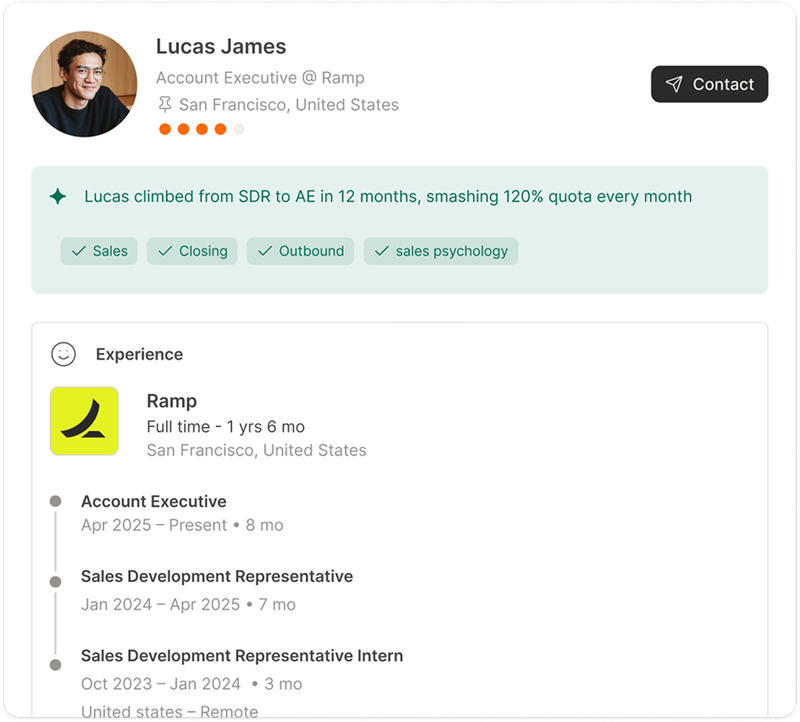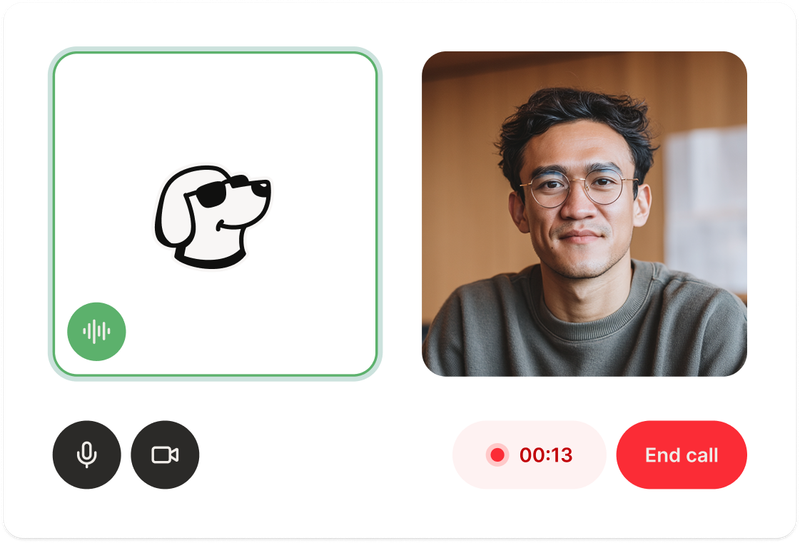How to Screen Candidates With AI in 2025
Finding the right candidate for a job can be a complex process. Many hiring teams receive far more applications than they can realistically review by hand.


5 min read
Published on 10/24/2025
Finding the right candidate for a job can be a complex process. Many hiring teams receive far more applications than they can realistically review by hand. Traditional methods often involve reading each resume, scheduling phone screens, and trying to compare many applicants quickly.
New technology is changing this process. AI screening tools are now being used to help teams sort and evaluate candidates more efficiently. These tools analyze candidate data and help identify people who best fit the job requirements.
This article explains how AI candidate screening works, why it is becoming more common, and what methods are available for teams looking to improve their hiring process.
What is AI candidate screening?
AI candidate screening refers to computer systems that review, assess, and shortlist job applicants based on specific data points and criteria. These systems can process large amounts of information from resumes, applications, and even interviews in a fraction of the time it would take a human.
Unlike traditional applicant tracking systems (ATS) that often review resumes using a fixed set of criteria, AI systems learn based on feedback and improve their algorithms over time. As a result, the system can become more precise and efficient with each use.
The technology works by analyzing patterns in successful hires and applying those patterns to new candidates. For example, if previous high-performing employees in a role shared certain educational backgrounds or skills, the AI learns to identify and prioritize similar characteristics in future applicants.

How AI candidate screening works
AI candidate screening follows a clear sequence of steps to process applicants and help hiring teams make decisions.
Resume parsing begins the process. AI software scans each resume, extracting structured information such as work history, education, skills, and certifications. It recognizes both keywords and the context in which they appear, allowing it to understand experience even if described in different ways.
Candidate ranking comes next. The AI compares information from each resume to job requirements, applying algorithms that score each candidate based on how closely they match the desired profile. This ranking uses criteria set by the employer, such as specific skills, years of experience, or types of education.
Automated assessments may follow. These can include job-related skills tests, cognitive ability quizzes, or behavioral questionnaires. AI analyzes the results, looking for patterns that indicate a candidate's aptitude or fit for the role.
Finally, human review completes the process. The AI presents recommendations to recruiters, highlighting candidates who meet or exceed required criteria. However, the final decision remains with humans, who review suggestions, consider additional factors, and select which candidates to move forward.
AI screening methods used by hiring teams
Hiring teams use several AI methods to make candidate screening more efficient and reliable. Below are the most common approaches for using artificial intelligence resume screening and other AI-powered techniques
AI resume screening
AI resume screening uses computer programs to read and analyze resumes automatically. The technology extracts important information like job titles, education, skills, and relevant experience.
Two main approaches exist:
- Keyword matching: Checks for specific words or phrases that match the job description, such as "Python" or "project management"
- Contextual analysis: Understands the meaning behind words, recognizing when candidates used certain skills in previous roles even without exact keyword matches
After analyzing this information, the AI assigns scores to candidates based on how well their backgrounds match job requirements.
AI Interviews

AI interviews use automated systems to conduct initial candidate conversations through text, voice, or video formats. These tools ask predetermined questions and analyze responses using natural language processing.
The technology evaluates multiple factors including:
- Response content: What candidates say about their experience and skills
- Communication patterns: How candidates structure answers and express ideas
- Behavioral indicators: Non-verbal cues in video interviews like facial expressions and engagement
AI interview platforms generate reports highlighting candidate strengths, potential concerns, and compatibility with job requirements. This allows recruiters to review more candidates while standardizing the initial interview experience.
AI-based skills assessments
AI-based skills assessments are online tests or games designed to measure candidate abilities. These assessments evaluate cognitive skills, technical expertise, or behavioral traits.
Candidates complete tasks or answer questions, and the AI instantly scores performance. Results show how each candidate's skills compare to job requirements, providing objective data for hiring decisions.
Choosing AI screening software
Selecting AI screening software involves evaluating specific criteria. Each organization has unique requirements, and not all software fits every workflow or set of priorities.
Data privacy and compliance
AI screening software processes personal and often sensitive data. Look for systems with transparent algorithms that explain how decisions are made. Regular bias audits check for patterns that could unfairly disadvantage certain groups. GDPR and other privacy regulations set standards for how candidate data is stored, shared, and deleted.
Integration capabilities
Many organizations use applicant tracking systems to manage recruitment. AI screening software connects with these systems through direct integrations or APIs. Integration allows data to move between tools so recruiters can see all candidate information in one place.
Cost and scalability
Pricing varies based on features, number of users, and volume of candidates processed. Common models include:
- Subscription pricing: Monthly or annual fees
- Per-hire pricing: Costs based on successful placements
- Usage-based pricing: Fees tied to number of candidates screened
Scalability refers to how well software handles increased candidate volumes as hiring needs change.
Reporting and analytics
AI screening software includes dashboards and reporting tools. Metrics tracked may include time-to-hire, pass rates, candidate scores, and diversity statistics. Analytics help recruiters measure screening effectiveness and identify trends or issues.
Best practices for fair AI screening
Screening candidates with AI involves more than automation. Fairness and positive candidate experiences depend on how the technology is designed and managed.
Set transparent job criteria
Clear job criteria describe the skills, experience, and qualifications needed for a role. When requirements are objective and specific, AI screening tools can evaluate every candidate using the same standards. This reduces the risk of decisions being influenced by personal opinions or biased hiring patterns.
Conduct regular model audits
Model audits are periodic checks of how AI screening tools score and rank candidates. These audits review results for different demographic groups to identify potential bias. When differences are found, teams can adjust the model or process to correct unintended discrimination.
Use inclusive training data
AI models learn patterns from data sets used during development. When these data sets represent diverse backgrounds, experiences, and demographics, the AI is less likely to learn biased patterns. Including data from different industries, education levels, and personal backgrounds helps AI recognize talent more broadly.
Communicate with candidates
Candidates are informed when AI is used in screening, often through application forms or interview invitations. Clear communication explains what to expect, how information is used, and who to contact with questions. Some organizations offer feedback or appeal processes for AI-driven decisions.
Implementation steps for AI screening
Map current recruitment workflow
List all steps in your current recruitment and screening process. Look for delays, repetitive tasks, or inconsistencies. Identify which steps could be automated or improved by AI tools for candidate screening.
Define success metrics
Decide on measurable goals before introducing AI. Common metrics include:
- Time-to-hire: How long it takes to fill a role
- Candidate quality: How well hires perform in the job
- Screening efficiency: How many applications are filtered accurately
Record these metrics to track changes over time.
Select and pilot an AI tool
Research AI screening tools that meet requirements and align with existing systems. Test the tool with a small group, such as one department or specific job role, before making it available organization-wide.
Train team members
Provide training sessions to recruiters and hiring team members. Explain how the AI tool works, what it can and cannot do, and how to interpret recommendations. Ensure everyone understands how to combine AI results with human judgment.
Monitor and optimize
Collect data on AI screening performance compared to earlier metrics. Gather feedback from team members and candidates about their experience. Adjust tool settings or processes as needed to improve accuracy and efficiency.
Future trends in AI job screening
AI job screening continues evolving as new technologies and data sources become available.
Predictive retention scoring uses AI to estimate how likely candidates are to stay in jobs and succeed over time. These models analyze patterns in resumes, assessments, and interview responses to generate scores reflecting probable tenure and performance.
Multimodal assessments combine information from several sources. Video interviews, audio recordings, written responses, and behavioral data are analyzed together to build more complete candidate profiles.
Real-time skill validation involves adaptive testing during assessments. AI presents questions or tasks that change based on candidate answers, showing current ability in specific skills with dynamic adjustment for each person.
Autonomous end-to-end hiring refers to AI systems managing entire recruitment processes from job posting to offer generation. These systems can operate with minimal human input while maintaining options for review or approval at any stage.
Hire faster with Staffer's AI-first recruitment platform
Staffer is a comprehensive hiring platform with AI built into every step of the hiring process. Unlike traditional ATS systems with bolted-on features, Staffer's core AI engine filters and ranks applicants automatically based on customized job criteria, dramatically reducing manual resume review time.
The platform functions as a complete applicant tracking system while leveraging advanced AI screening throughout the entire hiring workflow. From initial application processing to interview scheduling and candidate communication, every step is enhanced and automated through AI.
Each hiring project continuously improves Staffer's AI capabilities, as the system learns from successful placements and hiring patterns. The result is a fully automated recruitment solution that combines the efficiency of artificial intelligence with the option for human oversight, delivering higher quality candidates in less time with minimal manual intervention.
FAQs about AI candidate screening
Which industries use AI candidate screening most frequently?
Technology, healthcare, retail, and customer service industries commonly use AI candidate screening due to high application volumes and clearly defined skill requirements for many roles.
How much historical hiring data do companies need before implementing AI screening?
AI screening software can process applications immediately with minimal historical data, though accuracy improves over time as the system learns from more hiring outcomes and successful placements.
Can job candidates request to avoid AI screening processes?
While some candidates may request human-only screening, most organizations include AI screening as a standard part of their recruitment process for consistency and efficiency across all applications.
How do AI screening tools connect with existing applicant tracking systems?
Most AI screening platforms offer API integrations and direct connections with popular ATS platforms like Greenhouse, Workable, and Lever, allowing seamless data transfer between systems.
What role do human recruiters play when using AI candidate screening?
Human recruiters review AI recommendations, conduct interviews with top-ranked candidates, and make final hiring decisions. They can override AI suggestions based on factors the system might miss, such as cultural fit or unique circumstances.
Join the Bench. Become an Early Adopter.
Don’t wait for the hiring revolution — lead it. Get early access to the smartest recruiter you’ll ever meet.
